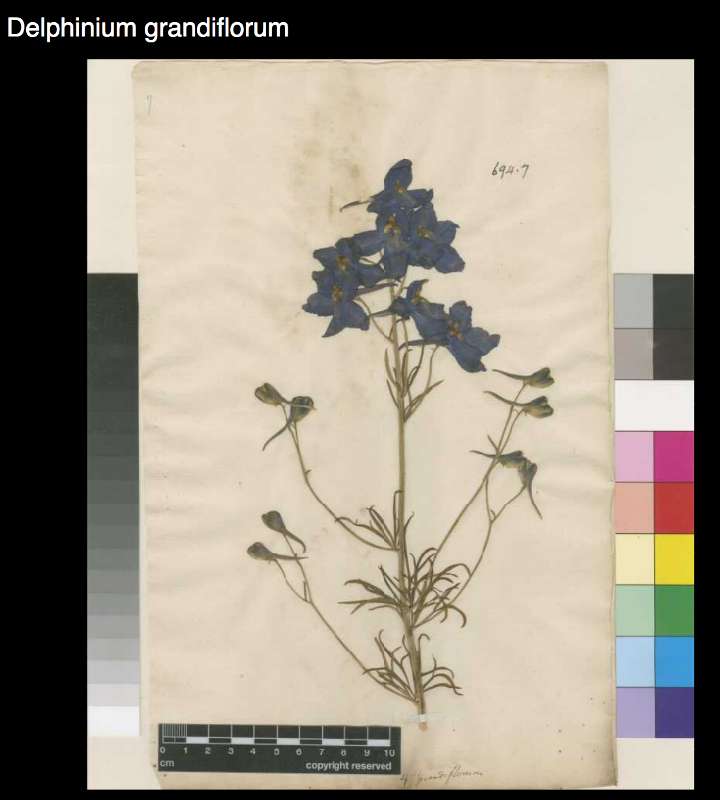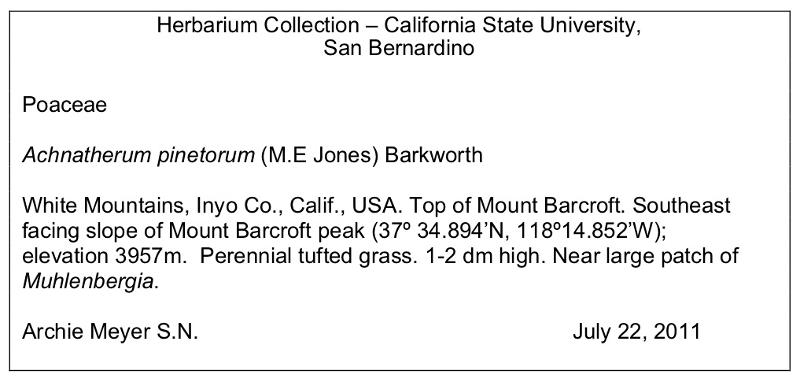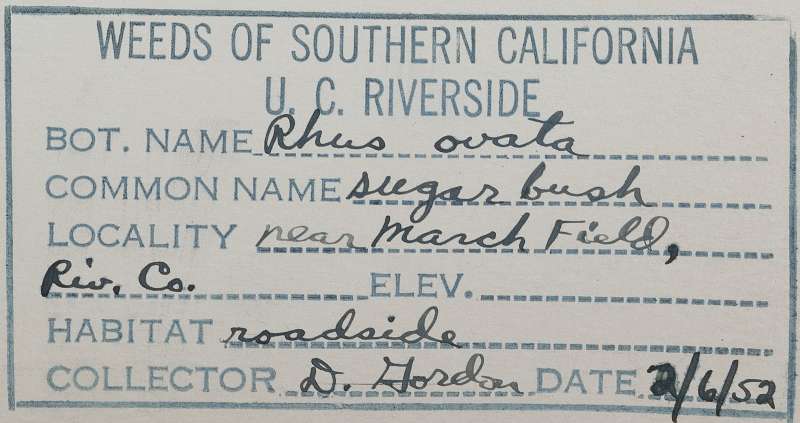Herbarium Specimen Labels
The label accompanying a good specimen can be a significant contribution to scientific records. Make labels before attempting to mount the specimen on herbarium paper. Assume that your work will be of value for hundreds of years later. Faded ink or incomplete or illegible entries can negatively impact the usefulness of the specimen. Labels should be printed on good rag content and acid free bond paper about the size of a 3" x 5" index card; large enough to contain complete information, yet small enough not to take up too much room on the herbarium sheet.
Required Label Information
A pressed plant without label information has no scientific value.
The following information is essential:
Plant Family: (ie. Asteraceae)
Scientific name: Genus and specific epithet with authority.
Collector(s): Full first and last name and middle initial.
Detailed location: Give enough detail to locate the plant(s) in order to obtain further research material. The location will consist of country, state, county or municipality and a description of the location in reference to roads, road junctions, mile markers and distances from cities and/or towns. Include any permanent built landmarks and/or natural geographic features. Latitude/longitude, section, township and range, and elevation may also be helpful. A location taken with a Global Positioning System (GPS) is a desirable complement to the locality description, but cannot be used as the sole locator. For more information on GPS referencing, see: https://www.floridamuseum.ufl.edu/herbarium/methods/Georeferencingbestpractices.htm
Habitat: the type of plant community (eg. chaparral, coastal sage scrub) where the plant is growing and, if known, other companion plants growing in the vicinity.
Plant habit: describes the form of the plant (tree, shrub, vine, herbaceous perennial, annual).
Plant description: For perennials and woody shrubs, measure and record the height and spread. For trees, measure spread and diameter of trunk at breast height (dbh). Describe characteristics of the plant which may be lost upon drying, such as flower/fruit color and fragrance, leaf orientation and unusual aroma.
Collection number: optional
Date of collection: Format with the month spelled out or abbreviated and 4 digit year. (30 April 2020, April 30, 2020 but NOT 4/30/20).
All measurements, elevation, distance must be in metric units.
Information that should NOT be on a label
Remember that herbarium specimens serve as data points. That means that all information on the label should consist of observations that you make about this particular plant and its surroundings. No information should come from books or other sources.
Furthermore, anything that is obvious to someone looking at the specimen should NOT go on the label. Only note it if the characteristic is likely to disappear over time. For instance, you should NOT write that the plant "has opposite leaves" when the plant on the herbarium sheet has opposite leaves. In contrast, noting that the "petals are magenta with white strips in the throat" might be important if the flower turns gray overnight (it happens) or fades to brown over the next 300 years (that also sometimes happens).
Changing norms for herbarium label
Uses of herbarium specimens have changed over the centuries.
Herbarium specimens were originally used just to identify plants, and to describe and catalog plant diversity. Very little written information was needed to simply identify or describe a taxon. Many older specimens, such as Carl Linnaeus' specimen of Delphinium grandiflorum, below, have only handwritten notes about the plant's name.

As the uses of herbarium specimens have diversified, the amount of information expected on an herbarium sheet has increased.
- Studies that use herbarium data to track range shifts in taxa require good location data.
- Studies that use herbarium data to track changes in phenology (timing of fruiting, flowering, etc.) require good location data and an accurate date of collection.
- Studies that use herbarium data to track habitat changes benefit from habitat descriptions and date information on a label.
- Studies that use herbarium specimens to track changes in climate by sampling tissue for stable isotope composition require good information on the date collected, the location and elevation of the collection site, and factors that may affect the local environment, such as slope and aspect of the site, whether the plant was in the understory or out in the open, etc.
- ... And there are other uses.
The relatively recent push to get herbarium records into forms that are searchable and mappable requires that data on latitude and longitude be provided.
Below are two examples of labels from relatively recent collections.


Check your understanding:
Look at the herbarium label below:

The point is: the date is ambiguous. This would be important if you were studying phenology.
For the following questions, refer to the herbarium specimen linked here. (It will pop up in a new tab or window.)